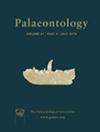对塔利怪物的三维解剖使人们对它与脊椎动物的关系产生了怀疑
IF 2.3
2区 地球科学
Q1 PALEONTOLOGY
引用次数: 0
摘要
Tullimonstrum clusterium,也被称为Tully怪物,是一个众所周知的系统发育谜,其化石仅在Mazon Creek Lagerstätte发现。自1966年被发现以来,Tullimonstrum的亲缘关系一直存在争议,因为它有柄眼睛和长鼻的特殊形态很难与任何已知的动物形态进行比较。最近,Tullimonstrum是脊椎动物的可能性引起了人们的关注,人们认为Tullimontrum可能填补了早期脊椎动物化石记录的空白,为脊椎动物进化史提供了重要的见解。为了解决这一争论,我们使用高分辨率激光3D扫描仪从153个Tullimonstrum标本中收集了3D表面数据,并对长鼻中的探针进行了x射线显微计算机断层扫描(μCT)分析。我们对由此产生的综合3D形态学数据集的调查显示,以前被认为是子宫肌瘤、三叶脑、顶盖软骨和鳍射线的结构与脊椎动物的结构不可比较。这些结果进一步引起了人们对其脊椎动物亲缘关系的怀疑,并表明Tullimonstrum可能是一种非脊椎动物脊索动物或原口动物。本文章由计算机程序翻译,如有差异,请以英文原文为准。
Three‐dimensional anatomy of the Tully monster casts doubt on its presumed vertebrate affinities
Tullimonstrum gregarium, also known as the Tully monster, is a well‐known phylogenetic enigma, fossils of which have been found only in the Mazon Creek Lagerstätte. The affinities of Tullimonstrum have been debated since its discovery in 1966, because its peculiar morphology with stalked eyes and a proboscis cannot easily be compared with any known animal morphotypes. Recently, the possibility that Tullimonstrum was a vertebrate has attracted much attention, and it has been postulated that Tullimonstrum might fill a gap in the fossil record of early vertebrates, providing important insights into vertebrate evolutionary history. With the hope of resolving this debate, we collected 3D surface data from 153 specimens of Tullimonstrum using a high‐resolution laser 3D scanner and conducted x‐ray micro‐computed tomographic (μCT) analysis of stylets in the proboscis. Our investigation of the resulting comprehensive 3D morphological dataset revealed that structures previously regarded as myomeres, tri‐lobed brain, tectal cartilages and fin rays are not comparable with those of vertebrates. These results raise further doubts about its vertebrate affinities, and suggest that Tullimonstrum may have been either a non‐vertebrate chordate or a protostome.
求助全文
通过发布文献求助,成功后即可免费获取论文全文。
去求助
来源期刊

Palaeontology
地学-古生物学
CiteScore
5.60
自引率
3.80%
发文量
43
审稿时长
6 months
期刊介绍:
Palaeontology publishes a wide variety of papers on palaeontological topics covering:
palaeozoology
palaeobotany
systematic studies
palaeoecology
micropalaeontology
palaeobiogeography
functional morphology
stratigraphy
taxonomy
taphonomy
palaeoenvironmental reconstruction
palaeoclimate analysis and biomineralization studies.
 求助内容:
求助内容: 应助结果提醒方式:
应助结果提醒方式:


